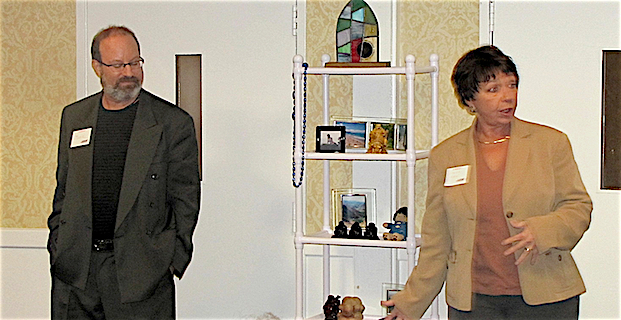by Elle Ray | Apr 25, 2017 | Small Business Advice
Become a Business Mentor to Pay It Forward

While helping your customers is rewarding, the word “customers” implies that you got paid for the service or products you provided. And that’s certainly all well and good, especially when you strive to actually help people.
But there’s a certain satisfaction you get when you go out of your way, with no compensation in sight, to help another as a business mentor. Every major religion, every spiritual philosophy and every successful business person understands the “pay it forward” mentality that truly reaps the biggest benefits — for you and the recipient of your efforts.
Always in Style
“Each one teach one” is a philosophy, or way of life, that originated in the U.S. during the early days of slavery. Africans were thought of as chattel by their owners and not worth the time or resources it would take to educate them. Leaders within the slave community started the practice of teaching reading and writing in secret. And they passed on their knowledge to their friends and family members one at a time.
In true leadership fashion, they encouraged each new student to pass on their newfound knowledge to another person. If each one who gained new knowledge passed it on to one person and the pattern continued, then they believed that eventually everyone could become educated. And it worked!
But We’re Not Enslaved Anymore
The each one teach one philosophy gained traction over the years, and many religious and community organizations have adopted the concept into their practices today. It isn’t a stretch then to think that you too — as a small business owner, successful entrepreneur or seasoned professional — can pass on your knowledge to someone who could really benefit from it. The end result may be that no one goes without fulfilling, prosperous work they love to do.
The organization called SCORE, a division of the Small Business Administration, is one example of a group of professionals, mostly retired, who volunteer their time to become business mentors and share their expertise with new or wanna-be business owners. Some areas where their experience is prized by hungry knowledge-seekers include:
- IT
- Accounting
- Legal
- Branding
- Marketing
- Business development
So How Can You Get Involved in Becoming a Business Mentor?
Once you make the intention to become a business mentor to small business owners who can really benefit from your expertise, your mentees will appear. That’s how the universe works. And if you don’t recognize those people as they cross your path, consider other sources to find willing learners:
- Your church. Ask your minister or someone in the office who may be involved in the business community.
- Business networking groups. As you talk to people to build your network, explain what you have to offer and ask if they know anyone with whom you might work (at no charge of course).
- Re-entry programs, such as those provided by your local Goodwill office or through the courthouse. Former offenders often have difficulty finding lucrative opportunities for work, especially when they’re first released from prison. Many are interested in starting their own businesses.
- The local community college counseling office, which can direct you to a program administrator or other small business advocate who works with students of all ages trying to get settled in a new business.
Once you start as a business mentor, you’ll begin to reap your own rewards immediately, not the least of which is feeling pretty good about yourself. When you pay it forward and follow the premise of the original each one teach one philosophy, you’ll make a difference in the lives you touch — in your community and in the world.
Ray Access is a content marketing firm that delivers targeted words to empower your business. Contact us about your specific project to receive a quote or discuss your needs. We write website copy, blog posts, e-newsletters and more. Everything we do is thoroughly researched, professionally edited and guaranteed original.
by Mark Bloom | Apr 17, 2017 | Content Marketing
Answers You Seek Regarding Content Marketing
It’s a question that has been around as long as the Sears catalog: Does content marketing work? If it really, truly worked, every business would devote a significant portion of its marketing and advertising budget to content marketing — instead of, say, Super Bowl ads or Sunday newspaper coupons. And good content writers would be in demand and appreciated for what they do.

The short answer is that content marketing does work and good content writers are in demand. The long answer, however, is a bit more complicated. In this heavily researched blog post, you’ll learn the complex truth about content marketing — so you can stop asking, “Does content marketing work?” and start asking, “How can content marketing work for me?”
Define Your Goals
Any marketing strategy is only successful if it accomplishes its goals. So, when you begin a content marketing campaign, you have to first decide what you hope to achieve. Some marketing firms have general goals for your business, such as generating a personal connection, enhanced visibility, and sustained credibility on the Internet. But Ray Access sees these as social media goals, not content marketing goals.
Ultimately, you want your efforts to pay off in more sales. That’s why you’re willing to invest in the expense of content marketing — which, by the way, costs less than most other marketing strategies. Most businesses want their content marketing to achieve the goals reflected in an article by GaggleAMP:
- Generate consistent content
- Market the content you produce
- Grow your website traffic
- Convert your new visitors into customers
Getting to Profitability
According to The Content Marketing Ninja and ProfitWell.com, your business requires two factors to answer “Does content marketing work?” They are:
- Amazing quality in your content
- A marketing strategy
Quality has to do with both the proficiency of your writers and the purpose of the writing. Experts believe that the purpose of content marketing is to educate, inform or entertain. Since you never know what may go viral, you have to first give people a reason to read your content.
Great Content Isn’t Enough
Does content marketing work? For you to answer that question, you have to fully commit to the effort, according to the Search Engine Journal. While creating good content is a start, you must realize you’re going to spend more time promoting than creating.
Indeed, Innovative Marketing Resources (IMR) asserts that great content is only part of the equation; you also need a sales process. Marketing has to lead to sales to be effective. In one terrific analogy, they compare gasoline to content: “Gas to a car is what content is to content marketing.” In other words, you need the car to get anywhere. Pouring gas over four tires and engine parts gets you nowhere, even if you add more gas.

Specific Targets Are Required to Triumph
Remember START. You must learn about the people you want to buy your products or services. As James Ellis has shared: “Whoever knows his audience best, wins.” You have to provide content that your audience wants. It has to be relevant to them in their lives. Even IMR directs content marketers to continue to ask questions about your customers to overcome their objections.
Instead of asking, “Does content marketing work?” ask yourself, “What type of people are in my audience?” There are three different types of people:
- Freeloaders. There are many people who never pay for anything. They search the web to find answers to their issues so they can do it themselves. Provide them the information they seek, but never expect them to pay for your products or services.
- Try It Yourselfers. Most people fall into this category. They want your information so they can try it themselves. They soon realize they need what you offer, bite the bullet and buy from you. Since your content got them started, they remember you.
- Professional Businesspeople. These people are, surprisingly, quite rare. They value their time enough to know right away what they can and can’t do. They see the worth in buying what you have and don’t hesitate if it can help them reach their own goals.
Does Content Marketing Work?
To succeed at content marketing, you need quality content, but that’s just the place to start. Put that content in front of as many eyeballs as possible — and as many SMART eyeballs as possible. The Freedompreneuer Business Academy believes in spreading content-rich information through multiple channels and platforms, including:
- Blog posts
- Podcasts
- Webinars
- Videos
- Books and ebooks
- Free downloads
James Ellis points out that attraction content doesn’t convert, and conversion content doesn’t attract. You need both: content to attract traffic and then content that can convert that traffic. Ray Access creates blog posts that attract your audience and website content that converts your traffic.
Does content marketing work? It doesn’t matter whom you ask, the answer is yes. But you’ve got to work your strategy. Content marketing only begins with great content. You’ve got to target it, promote it and distribute it.
Ray Access is a content marketing firm that delivers targeted words to empower your business. Contact us about your specific project to receive a quote or discuss your needs. We write website copy, blog posts, e-newsletters and more. Everything we do is thoroughly researched, professionally edited and guaranteed original.
by Elle Ray | Apr 11, 2017 | Communication
Don’t Let Fear of Public Speaking Derail You
Getting up in front of a group of people to make a case, pitch a product or tell a story is an ideal opportunity to make an impression. Take advantage of it whenever you get the chance. If you’re a small business owners seeking to make your mark, it’s a great way to spread your message to a number of people at the same time.

Even with all the presentation tips at your disposal, however, you may be reluctant. Psychologists agree that public speaking is the second most common fear among adults — coming in a close second only to the fear of death. Like every effective marketing tool, it takes work, planning and gumption to do it successfully. But it’s worth it, so don’t pass up a chance to speak.
Why Is It So Hard?
The most common reason for the devastating (and paralyzing) fear boils down to a set of mostly illogical and unfounded fears:
- Fear of failure
- Fear of embarrassment
- Fear of not being good enough
- Fear of rejection
For many, the fear of public speaking wraps itself up in the number one fear, leading to the idea that you might get up in front of the group and actually die! But don’t worry: “death by public speaking” is not a thing. You can conquer your fears by following presentation tips from your friends at Ray Access. Effective presentation tips tackle the physical, emotional and mental aspects of your fear.
Try It, You Just Might Like It!
Once you start reaping the rewards of making a rousing speech and getting positive feedback, you probably won’t be able to shut up. No one says overcoming fear is easy, but it is truly possible. Here’s how:
- Acknowledge your fear. Accept the fact that you’re going to be nervous; it’s actually a good thing. Instead of forcing yourself to overcome it or feeling shameful about it, tell yourself that you’re nervous because you care.
- Give it appropriate billing. In the grand scheme of life (and your business), how important is it that you follow all the presentation tips to make a solid gold speech? Compared to losing your leg? To going hungry? To losing your home? Maybe not so much. Put your speech in perspective.
- Get real. There’s very little chance that you can please everyone all the time — no matter who you are and how well you speak. Give up the notion that you have to please everyone and focus on the few who really matter.

- Write it down. You shouldn’t necessarily read your presentation, but having it written down — in a font large enough to glance at — serves as a great backup in case you do freeze. As a former speech writer, I know that even the best presenters use written notes (and usually have the entire presentation written word for word).
- Practice. Stand in front of the mirror and read your presentation. Get your family or friends to agree to give you feedback you can use. Or record yourself and watch the video to see how you might improve.
- Breathe normally. Holding your breath, hyperventilating or taking shallow breaths increase the physical side effects of your nervousness. One of the most helpful (and powerful) presentation tips is to remember to take a deep breath before you go on and notice your breath as your speak. The psychiatrist Fritz Perls says: “Fear is excitement without the breath.”
- Visualize yourself speaking. See yourself standing erect, smiling, pausing at all the right junctures and engaging your audience. Visualization works for everyone from star athletes to CEOs; it can work for you.
- Think about your audience. Presentations aren’t about you. Remember that you’re giving this speech to help people solve a problem, find a better solution and hire the best in town. Your speech is for your audience, right? When it’s all about them, your feelings don’t matter as much anymore.
- Play it through. Imagine that you’ve finished; what’s the worst thing that could happen? Even if you made mistakes, so what? You’re not giving a speech in front of a group armed with stones (or spare shoes). When you realize that nothing dangerous can occur, you’ll relax. Consider how you’d treat a colleague who bombed. Worse case, you’re not asked back. Best case? Endless opportunity.
- Embrace it. With practice, your nervousness becomes an integral part of your preparation. You understand that once you start talking, you’ll be fine. After a few tries, you’ll realize you aren’t going to die up there. In fact, you actually may make some sales — as well as good connections — from the opportunity. Aren’t you glad you persevered?
- Bonus tip. Don’t do it by yourself. Bring along a coworker, colleague or employee. There’s no law that says presentations have to be given by one and only one person. Share the love, and it’s easier for both of you. Presentation tips don’t get easier than this one.
Ray Access is a content marketing firm that delivers targeted words to empower your business. Contact us about your specific project to receive a quote or discuss your needs. We write website copy, blog posts, e-newsletters and more. Everything we do is thoroughly researched, professionally edited and guaranteed original.
by Mark Bloom | Apr 4, 2017 | Content Provider
So Your Website Shouldn’t Emulate CNN or Fox
“Focus your message.” That’s what professional writers and newspaper editors tell you. Don’t make your readers work for the message — give it to them straight. When it comes to your business website, the advice is unsurprisingly the same: focus your message.

While main news websites like CNN, Fox News, BBC, and USA Today tell their writers to focus their message, they don’t always follow their same advice when it comes to their websites. Their front pages are a conglomeration of stories that each compete for your eye when you visit. You really need to work to find what’s important to you.
What News Sites Get Right
News organizations are designed to please everyone; they want to satisfy all the demographics with one product. And in their own way, news websites do follow the “focus your message” advice, despite the plethora of competing stories and the mix of ads and editorials:
- News sites effectively compartmentalize departments.
- Large headings draw your eyes to the biggest stories first.
- White space plays a role in guiding your eyes.
- Placement indicates, however subtly, what’s more important.
News websites have to organize their content so you can find the stories you’re looking for. The most important stories are at the top of the page and to the left, delineated by the largest heading. If you want the sports scores, you know to go to the Sports section. And of course, all news sites have a robust search feature.
What News Sites Get Wrong
If you’re used to news websites, you’ve learned how to get around, but to a newbie, the pages are a mishmash of words and pictures. Instead of focusing their message, it seems more like they’re throwing everything on the page to see what sticks. And in a way, that’s exactly what they’re doing — in hopes you’ll find what you’re looking for.
The front page of any news site just seems to keep going and going as you scroll down. One story after another. Videos. Advertisements. Links. Headlines. It can be overwhelming. And most days, the biggest news story isn’t obvious. Readers often give up or give in to the shortcut of the Search field.
Focus Your Message
When you look at your own business website, ask yourself how focused it is. Are you delivering one message or ten? Does your content compete with itself? When you first open your website, where are your eyes drawn?
Your website message should be clear, consistent and focused. Unless you’re trying to offer something for everyone, you can’t afford to throw copy on the wall hoping something sticks. When visitors arrive at your website, they should be able to tell right away what your company does, the benefits your company offers and the reasons to buy from you. Your website content must focus your message, boiling it down to its essence.
The Purpose of Your Home Page
Today’s website designs allow for long pages. With a lengthy home page, you have the space to identify your target audience, answer common questions and explain the advantages of your products or services. You need that space to differentiate your business from your competitors. If you don’t have much content on your home page, apart from photos, you’re missing an opportunity.
Ultimately, your website has a purpose: to generate phone calls and emails from your next customers. If it’s not doing that, then you need to change it. Populate your home page with compelling content. Just don’t mimic a news website. Focus your message.
Ray Access is a content marketing firm that delivers targeted words to empower your business. Contact us about your specific project to receive a quote or discuss your needs. We write website copy, blog posts, e-newsletters and more. Everything we do is thoroughly researched, professionally edited and guaranteed original.
by Elle Ray | Mar 26, 2017 | Communication
Connect with Customers Online for Best Results
As you follow the advice in last week’s article to write your website content, blog posts and other online communications in an informal tone, remember that the people you want to attract are also your potential customers. Treat them as such!

While every company wants to promote good will and build its brand, the ultimate goal of online marketing through content is to make sales. Connect with customers online through a variety of avenues from social media and your own website to email newsletters and webinars. Connect with customers online through entertaining articles, pertinent information and timely reports. In other words, give them what they want and need in one clean package.
Know Your Target
Writing conversationally is just the second step to successfully connect with your customers online. The first step is to correctly and succinctly identify your target market (aka your potential customers). Once they’re firmly in your sights, deciding what they like becomes much easier.
You can start by flat out asking them directly. Survey your audience to ask them if they prefer to get your great content via social media, in their email inbox or through your website (if they visit regularly). Then give them the goods.
Tweak Your Tweets and Boost Your Blog
One size usually does not fit all your potential clients. In fact, when you want to connect with customers online, you need to engage a wide range of platforms and tactics. But here’s a useful tip: short introductory sentences practically demand readers to click on your link, which gives them the impression that clicking was their decision. That gives them a stake in your message before they even see it.

And once they click through to your content, don’t disappoint your readers. Instead, try a few of these tactics to not just keep them on your site longer, but actually convert them into buyers:
-
Hold contests and giveaways that require visitors to answer questions or send you some other level of feedback. Engage your audience with prizes, kudos, recognition and surprises. Keep the games light enough so they are easy to play quickly, yet make sure they’re serious enough to keep readers coming back for the chance to play again.
-
Create videos of value. When you connect with customers online, you want them to feel good about the experience and pass it on to their friends. By creating humorous videos that contain your message, you give your audience a chance to repost and resend while they garner kudos from their friends and pass along your name.
-
Rehash news that’s of interest to your target demographic. Not everyone has local TV to watch the news anymore and even fewer people read newspapers. Help keep your customers and potential clients informed: choose those news stories that may affect them the most and rewrite them in blurbs throughout the day.
- Make it personal. Talk about yourself and why you started your business or why you work for your company. Share stories that other customers have told you. Explain how your product or service plays a role in your own life and that of your family and friends. People prefer to do business with people they like. Act like a friend instead of a pushy salesperson.
- Respond quickly. You can really make a statement that you care about your clients by making the effort to respond to inquiries as quickly as possible. Hardly anyone does that! Make your company stand out from the competition by being first in customer service. Everyone enjoys being pampered, treated like royalty and shown the highest level of respect. Be the person you want to attract, and you’ll continue to connect with customers online in meaningful (and profitable) ways.
Ray Access is a content marketing firm that delivers targeted words to empower your business. Contact us about your specific project to receive a quote or discuss your needs. We write website copy, blog posts, e-newsletters and more. Everything we do is thoroughly researched, professionally edited and guaranteed original.
by Mark Bloom | Mar 21, 2017 | Communication
Use an Informal Writing Style to Engage Visitors
It’s easy, when you’re face-to-face with people, to connect with them. You shake their hands. You look into their eyes. You use inflection to share your mood. Studies have revealed that 93 percent of personal communication is non-verbal. When communicating, more than the actual words you use, it matters:
- How you look
- How you hold your body
- How you use facial expressions
Connecting with people online, therefore, is inherently more difficult. No one can see you, unless you post a video — which is always a good idea when feasible. Usually, as in this particular case right now, you can’t see an expression or interpret body language. All you get are these words. Even with an informal writing style, how is it possible to connect online? We’ll tell you.

Write Like You Speak
Do you see what we did at the end of the last paragraph? That little aside — those three words — created an intimacy between the writer and the reader. An informal writing style helped create the connection, but it also helped that it flowed naturally out of the conversation. And yes: even a one-sided conversation can create a connection.
When you’re creating content for your website, either right on the page or in a blog, write like you naturally speak. With an informal writing style, in addition to being clearer, you get two distinct advantages:
- Your personality shines through the words. People who know you can tell you wrote it, and those who don’t know you gain a sense of who you really are.
- Your words tend to relate to your readers better. When you talk, you’re speaking to someone else, not at them. You often invite a response. Write like that, and you’ll engage your readers.
Connect with Your Online Audience
Below are five ways to keep your website visitors reading. All of these suggestions have been proven through the experience of professional website writers and bloggers. You can use them yourself to craft more engaging online copy:
- Informal writing styles charm your readers. Most people are surprised to find answers to their questions written in a comfortable, everyday tone. They expect an academic exercise in comprehension. Everyone has had the experience of coming upon a website or online report that seems like it was written for a professor. And that can insult your readers who may not grasp your intentions or your meaning.
- Use contractions, just like you do in everyday speech. Very few individuals talk without using contractions. If they do, they appear stilted, awkwardly formal and not someone you want to spend more time with. Be the opposite, and readers willingly spend more time with your words.
- Informal doesn’t mean humor or profanity. You can be professional without resorting to humor or profanity. The purpose of online content is to build trust with your readers. You can’t do that by swearing. Be professional. Provide answers. Say what you mean. But keep it informal.
- Keep your sentences relatively short. Good writing mixes long-winded sentences together with short, stout declarations. Like this. But don’t overdo the long sentences. They’re difficult to read on a screen, and they don’t lend themselves to comprehension. Don’t lose your audience to verbosity.
- Use whitespace effectively. Yes, it matters even where there are no words. It can be daunting for a reader looking for a specific answer to stare at a long block of text. An informal writing style includes short paragraphs, numbered or bulleted lists and subheads. Make your page look attractive and easy to navigate.
Ray Access is a content marketing firm that delivers targeted words to empower your business. Contact us about your specific project to receive a quote or discuss your needs. We write website copy, blog posts, e-newsletters and more. Everything we do is thoroughly researched, professionally edited and guaranteed original.
by Elle Ray | Mar 13, 2017 | Small Business Advice
Small Business Tax Tips That Just Make Sense
Did you know you may be able to deduct part of the cost of that new water heater you installed in your house? How about that class you took that taught you how to use social media to promote your business? Ever think the new treadmill you put in your basement could serve as a tax deduction?

Fact is, small business owners — particularly sole proprietors and partners — usually are unaware of all the potential small business tax tips they’re missing. In 2014, the most recent year when statistics are available, the IRS reported that about 24.6 million tax returns listed income from non-farm related sole proprietorships. That’s 2.3 percent higher than in 2013.
Taking It to the Bank
Of the more than $1.78 billion earned by those solo entrepreneurs, only a little more than $9 million was deducted for home offices. And that’s 1.3 percent lower than in 2013. That’s just downright crazy!
The point of the matter is: if you aren’t taking all the deductions you legally can, you’re giving Uncle Sam extra money to take to his bank. So if you’re tired of letting your hard-earned dollars slip through your fingers just because you don’t know the most recent tax codes or don’t think you’re allowed to follow too many small business tax tips, then grab a pencil and get out your calculator — you very well may get a bigger return or a lower tax bill if you pay attention to the following small business tax tips.
DIY or DIFY
There are plenty of easy-to-use small business tax tips and tax programs available so that you can do it yourself (DIY). On the other hand, if you have an astute accountant who also provides business advice, ask him to do it for you (DIFY). Either way, it pays for you to know your rights and know how to take advantage of those rights. For example:
- The Home Office: This is one of those small business tax tips that baffles many entrepreneurs, yet it’s one that’s easily overcome. If you have an office dedicated to work, simply find out what percentage of the square footage of your whole house it takes up. Then deduct that percentage of every expense — from home improvements and utilities to maintenance, rent or mortgage, and insurance payments you made.
- Make Space: If you don’t have a dedicated room, then invest in a simple accordion room divider and make a separate space dedicated to work. In addition to creating a legally deductible office, you’ll cut down on the distractions while you conduct business.
- Start Up Right: Long before you even crack a book or take in your first buck, you can be earning tax deductions. All the effort, money and advice you pay for to start your business are work products that you can deduct.
- Pay Yourself: Many small business owners and sole practitioners don’t get much of a paycheck for the first year or two. But that doesn’t mean you can’t be paying yourself in perks and necessities, such as a retirement account. Open a SEP IRA for tax deductions and retirement savings.
- Stay Healthy: When you work for yourself — whether as a sole practitioner, partner or owner of an S Corp with more than two percent equity — you can deduct your health insurance premiums off your personal 1040 tax returns.
- Pay Me Later: It may be too late this year, but consider sending invoices out on December 31 to clients. They can take the cost of your services off your taxes, but you won’t have to report the income until the following year, if they wait at least a day to pay you.
- Take Heed: If your heart doctor told you to get an indoor exercise bike because the stress from your work is giving you high blood pressure, you may be allowed to deduct the cost as a medical expense if you meet the minimum required in other medical costs.
- Time Well Spent: Mileage adds up. Keep an electronic or old-school log of every mile you drive for business. And if almost every trip you take outside the house has a work-related component — from meeting a client for coffee to picking up extra printer paper — then that trip counts.
- Learn More: Self-improvement, professional development and skills training are all deductible on your taxes. And that includes books, money spent on meals, rooms, mileage and any other related expenses. So, as an example, if you want to do your own taxes next year, take a QuickBooks course and deduct the costs.
- Document, Document, Document: If there’s only one of these small business tax tips that you take out of this blog, we bet it will be this one. Save every receipt, write down the purpose of the receipt, who you were with, why you spent the money and what you were doing it for. Many small business owners worry about getting audited, but when you cover your butt with receipts (figuratively speaking), those concerns are declawed. And as the budgets for the IRS keep getting cut, your chances of undergoing an audit as a small business get lower every year. In 2014, only 0.3 percent of small business owners reporting less than $200,000 income were audited, according to the IRS itself.
Ray Access is a content marketing firm that delivers targeted words to empower your business. Contact us about your specific project to receive a quote or discuss your needs. We write website copy, blog posts, e-newsletters and more. Everything we do is thoroughly researched, professionally edited and guaranteed original.
by Mark Bloom | Mar 7, 2017 | Small Business Advice
Is It Valuable or Just Email Inbox Filler?

According to numerous experts, including Entrepreneur.com, email marketing is still an effective means of promoting your business and generating sales. This seems to be true despite anecdotal evidence suggesting that most people receive more than 100 email messages a day. Before you click that Send button, consider your own email habits.
Your email inbox is like your family. You think everyone treats it the same… until you learn otherwise. Some people keep their inboxes sparkling clean by dealing with each piece of email as it comes in, whether it’s important or just email inbox filler. These people are probably OCD. Other people fail so miserably that it feels like a victory whenever they get their inbox down to fewer than 20 waiting emails.
Things That Clog Up Your Inbox
Your email inbox isn’t just where SPAM goes to die; it’s also where all your notifications, newsletters and sales pitches end up. It’s strange that someone you don’t know would send you an email to sell you something you don’t want or need, but that’s just one type of email inbox filler. And they’re the emails that are easy to delete. Click… and gone.
But the notifications and newsletters — ostensibly things you’ve voluntarily signed up for — are a different matter. You want to read them, but you can’t find the time. So they just sit there: email inbox filler that takes up space and makes you feel guilty about not participating in the modern world. Eventually, they last long enough to lose their relevancy or you get tired of opening and closing them, like you sometimes do with the refrigerator door when you’re vaguely hungry. Then, click, and it’s gone.
Don’t Send Email Inbox Filler
Whenever you send email, whether it’s to one person or 100 people, bear in mind that your recipients don’t receive your message in a vacuum. It becomes part of the deluge to their email inbox every day. No matter how much time and effort you spent crafting your message, it might end up in the Trash.
To overcome that tendency, you can’t use email to sell your products or services to unaware recipients. If you try: click, and it’s gone. Instead, offer something of value:
- A free ebook that suits their interests
- Free entertainment, such as a link to a movie
- Free insight into your business that they can put to use immediately
- Free ways to save money on something they want
- A free lunch — although everyone will tell you there’s no such thing

Consider Your Audience… First and Foremost
It’s easy to compose an email to sell your products or services. After all, you know the benefits better than anyone. But unless you can give a valid reason and a sense of urgency, no one will even open your email. Unless you can show clear benefits, no one will follow the link to your website. Unless your recipients are in the frame of mind to buy — and buy now — you won’t make a single sale.
Ray Access sends out a newsletter once a month. You can sign up on our website. We try our best to provide value to all our friends, colleagues and customers. If we give you something you can use, our newsletter has done its job. We don’t expect you to race to our website to hire us. But we do hope that when you’re in the market for writing services, you’ll remember us. That’s the only job of a newsletter.
And that’s worth the risk of sending something you may consider email inbox filler, even just once in a while. We strive to improve with every single issue — to give you something of value. And that includes advice like this.
Ray Access is a content marketing firm that delivers targeted words to empower your business. Contact us about your specific project to receive a quote or discuss your needs. We write website copy, blog posts, e-newsletters and more. Everything we do is thoroughly researched, professionally edited and guaranteed original.
by Elle Ray | Feb 27, 2017 | Communication
The Media Landscape’s Shifting Regarding News
Those of you of a certain age may remember the TV commercial for hair color that said it left your hair looking so real that “only your hairdresser knows for sure.” Do you remember that? At least she had a hairdresser to tell us if the color was fake or real.
In today’s over-saturated news universe, there is no one person, organization or source totally without bias. None can be unequivocally trusted by every single citizen. These days, if the skies turned purple and a booming voice heard round the world shouted out answers clearly in every known language, you may wonder if there’d be naysayers who refuted its existence. But if it really happened, is it “fake news?”

Skeptics Abound
The skeptics in our society serve a purpose. They keep us all honest. Skeptics question everything they read or hear. They always ask for proof, for substance. They enjoy playing the devil’s advocate to make us question our assumptions to the core. For every faction who says they’re right, there are an equal number of people who believe just the opposite. Even facts are in dispute today. Welcome to the era of fake news.
It’s very unsettling. It’s troublesome when you have to take a poll to find out which apple is organic and which is laden with so many chemicals that it’s toxic. If you picked it from the tree yourself, does that mean it’s safe? You see water falling from the sky, yet you’re told that it’s not raining. What can you do when you can’t even trust your own senses? When does fake news start to become surreal?
Pick a Side, Any Side
As a former journalist and as a writer who today produces copy that’s read by many, Linda Ray of Ray Access has always prided herself in fair and accurate reporting. Everything she writes is researched from reputable sources. She checks the “About Us” page on websites to find out if they have potential conflicts that make their information questionable. She goes to original sources whenever possible to hear directly from the “horse’s mouth” what was said … or whinnied.
But does that matter anymore? Like beauty, fake news may lie in the eye of the beholder (or the reader). Upon learning a source’s political leanings, gender, age, race, sexual orientation, all of these things or none of them, do you believe the source more if the characteristics of the writer are more like your own? Would you simply dismiss out of hand every notion from someone who’s different from you?
In other words, is the source of information an actual fountain of credibility today? Is reality objective or subjective? Does first-hand experience mean anything at all or does it mean everything, meaning anything outside your experience can’t be trusted? Is education itself a sham? Does one plus one equal three?
Is reality objective or subjective? Does first-hand experience mean anything at all or does it mean everything, meaning anything outside your experience can’t be trusted? Is education itself a sham? Does one plus one equal three?
Only Time Can Tell
When doomsayers proclaim that the world will end next week by a giant meteor hurtling toward earth, some people believe it to be true. The impending disaster becomes news. When the week passes without incident, does it become fake news? And if so, do all those who went about their business, not believing a word of it, sit around over their usual morning coffee and say, “See? I was right, and you were wrong.”
But a problem remains, a problem similar to that of the boy who cried wolf. When a real planet flings itself out of orbit next year and we need to take shelter, that bell has been rung already. No one believes the scam the second time around. It’s immediately declared fake news without follow-up. The boy cried wolf too many times and lost his credibility.
Perhaps the only truth in today’s world is found in the lens of hindsight. Only by living through each day can we look back and see what was real news and what was fake news. And only by continuing to question each and every assertion can we comfortably say goodnight in peace, knowing that the answers will come tomorrow — that the only real news is yesterday’s news.
Ray Access is a content marketing firm that delivers targeted words to empower your business. Contact us about your specific project to receive a quote or discuss your needs. We write website copy, blog posts, e-newsletters and more. Everything we do is thoroughly researched, professionally edited and guaranteed original.
by Mark Bloom | Feb 21, 2017 | Editing
And Other Best Editing Practices That Can Help

Every article, blog post or website page — in fact, anything that will appear online — must be edited before it’s published. This seems like a no-brainer, an assertion that’s so obvious that no one would argue against it. But as you likely know, not everyone follows best editing practices. And it’s both unfortunate and so easy to fix.
Any professional writer worth her salt knows that a piece of writing is only as good as the editor behind it. Once you’ve seen your share of typos, misspellings, dangling modifiers, vague pronoun references and creative grammar, you begin to see the light. It’s like one of those “Ah-ha!” moments. You realize that if just one other person had read through the writing before it was published, 90 percent of the problems could have been corrected.
Mistakes Happen
It’s usually best to give your work to another person because a second pair of eyes can catch things in your own writing that you’ll never see for yourself. For example, your eye will fly right over mistakes such as:
- Misspelled names
- Missing words
- Incorrect pronoun use
- Wrong word use
You can find the mistakes you know are there, but it takes another person to see the mistakes you make that you don’t even know you make. You won’t pause to double-check names that look right to you. Your mind will fill in the missing words, so you won’t even notice they’re not really there. And the other errors will seem correct.
Best Editing Practices That Are Easy
Editing doesn’t have to be a difficult, expensive or drawn-out process. While a professional editor should review anything that involves your business, you don’t need to hire one for your personal blog. But you should learn some common editing tips so you too can get closer to best editing practices. Easy editing techniques include:
- Sleeping on it. This little tip really works, especially if you’re a good writer. Basically, after you’ve finished the first draft — and that means finished it completely — put it aside and don’t even look at it. Return to it the next day, when you’re refreshed but it’s not so fresh in your mind, and reread your words, checking to see if it’s as wonderful as you remember. Be objective and make the changes you need to make to improve the article. You will find lots of mistakes and things to change.
- Read it out loud. This tactic is common among novelists and screenwriters, but it can work for your online content, too. It’s one of those best editing practices that seems too easy, but simply by reading something out loud, to yourself or to another person, highlights obvious errors that you’d otherwise miss. Your eye’s trained to read just what’s on the page so the absence of words jumps out at you.
- Read it backward. If you’re sure what you wrote is bullet-proof, read it backward. You’ll find misspellings, and odd word choices that you’ll feel compelled to change. You won’t catch any grammar mistakes doing this exercise, but you’ll be amazed at what you do find. This may become your standard practice.
Ray Access is a content marketing firm that delivers targeted words to empower your business. Contact us about your specific project to receive a quote or discuss your needs. We write website copy, blog posts, e-newsletters and more. Everything we do is thoroughly researched, professionally edited and guaranteed original.














 Is reality objective or subjective? Does first-hand experience mean anything at all or does it mean everything, meaning anything outside your experience can’t be trusted? Is education itself a sham? Does one plus one equal three?
Is reality objective or subjective? Does first-hand experience mean anything at all or does it mean everything, meaning anything outside your experience can’t be trusted? Is education itself a sham? Does one plus one equal three?